Saturday, October 15, 2005
Silvered Æ antoninianus, Gallienus, Mediolanum, Göbl 217f
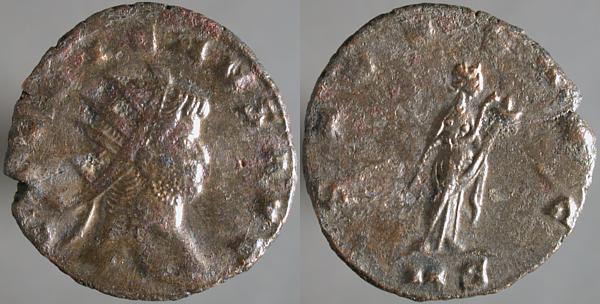
GALLIENVS AVG, Radiate head right, both ribbons behind | SALVS AVG, Salus standing right, holding snake in right arm, feeding it from patera in left hand. MS in exergue.
I recently asked what was in the patera often used by figures on Roman coins pouring sacrifices onto flaming altars. This topic quickly turned into a discussion of SALVS-type reverses. I now turn this to my own advantage, and take the easy way out.
Friday, October 14, 2005
Æ20, Samos (Ionian Island), Saloninus, SNG Copenhagen 1817
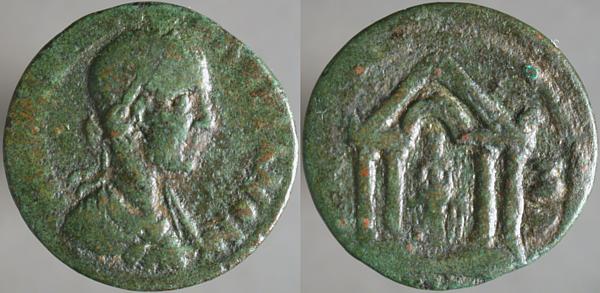
[ΛIKI CAΛΩ OVAΛEPI]ANOC, Laureate draped bust right | [CAMIΩ]N, Tetrastyle temple with statue of Samian Hera standing facing.
A bit about the Island of Samos and a bit about Saloninus. Note that when it says
“In 260 Gallienus elevated Saloninus to become Augustus...”that there's not good evidence for that. Certainly there survive a small number of coins of Cologne, where Saloninus was besieged, naming him Augustus. No coins of Rome, or any other mint, so name him. The Cologne coins seem to show not that his father acclaimed him, but that his acclamation was an emergency measure at Cologne after the revolt of troops under Postumus was underway. It was not sufficient to sway the troops back to Saloninus, whom they assassinated.
Thursday, October 13, 2005
Æ sestertius, Gallienus, Rome, Göbl 440i
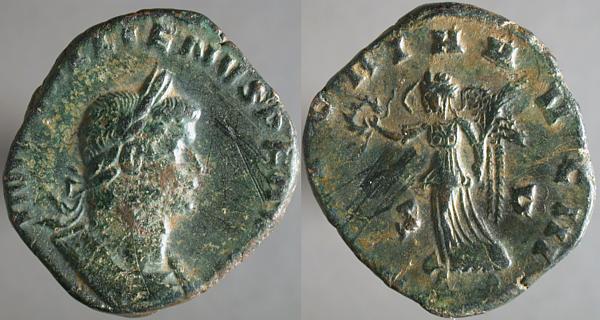
IMP GALLIENVS P F AVG, Laureate cuirassed bust right | VICTORIA AVG III,Victory advancing left, raising wreath in right hand and holding palm in left. S_C across fields.
The sestertius, worth four asses, during this reign like the as itself became more costly to produce than the antoninianus, itself worth eight sestertii. While a few sestertii were produced subsequent to Gallienus, it became a rarely-seen coin.
While there's no documentation for crippling inflation during the time of Gallienus, the steady elimination of small change and the debasement of the antoninianus, originally a debased silver coin worth 1-2 days skilled labor, into a small bronze piece with a silver surface, strongly suggests that it was happening.
Wednesday, October 12, 2005
Silvered Æ antoninianus, Tacitus, Rome, 275-276 C.E., RIC 95
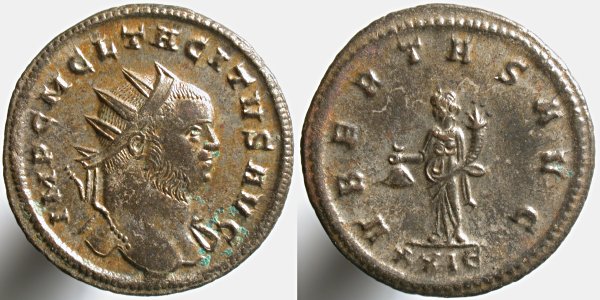
IMP C M CL TACITVS AVG, Radiate bare-chested bust right, slight drapery on left shoulder | VBERTAS AVG, Uberitas standing left, holding cornucopia right and purse left. XXIΕ in exergue.
Marcus Claudius Tacitus was acclaimed emperor by the senate about six months after the death of Aurelian, ending an interregnum during which Severina exercised power.
Tacitus took steps to avenge the assassination of Aurelian, and enjoyed some initial military success, but was himself assassinated after about 8 months of power He was succeeded by his half-brother Florian, whom he had named praetorian prefect.
Cool neck-beard, eh?
Tuesday, October 11, 2005
Æ19, Aegae in Aeolis, quasi-autonomous, SNG Copenhagen 19
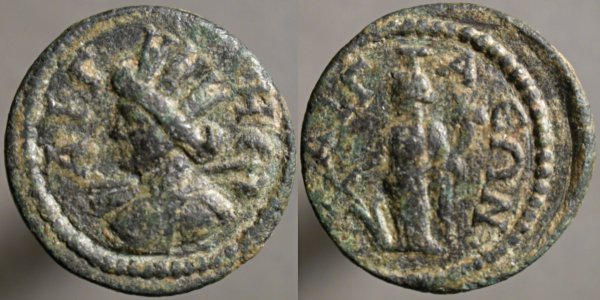
AIΓ_H, Turreted bust of city goddess (the Amazon Aegae, founder of the city?) left, bipennis held over right shoulder | AIΓ_A_EΩN, Dacia standing left, holding standards, with eagle holding wreath and lion at their bases. AN X in exergue.
Very similar designs were used at the nearby cities of Cyme, here and Temnos, here and here.
It's not understood how much sharing went on between provincial mints at this time, but among the possibilities:
Probably each of these schemes was used at some times and places.
Monday, October 10, 2005
Æ as, Mariniana, Rome, Göbl 217f
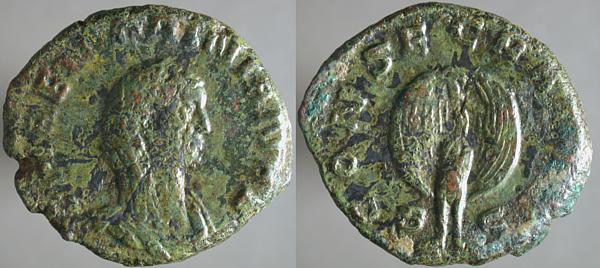
DIVAE MARINIANAE, Veiled draped bust right | CONSECRATIO, Peacock standing facing, tail erect, head right, S_C across fields.
All coins of Mariniana are posthumous, so her death apparently preceded her husband Valerian becoming emperor in 253. Nothing else is known about her, and it's not known if Gallienus was her son or if he was borne by an earlier wife of Valerian.
The as, introduced as a substantial bronze coin circa 280 BCE, had been reduced to something only slightly heavier than the antoninianus, which was worth 32 asses. While their relative weights were irrelevant when the antoninianus was a silver coin, it became quite relevant as the alloy used in antoniniani became more and more debased and finally it too was a bronze coin, with a bit of silver at the surface. Production of the as ended during this reign.
Sunday, October 09, 2005
Æ26, Dacia, Gallienus, Varbanov (2005) 92
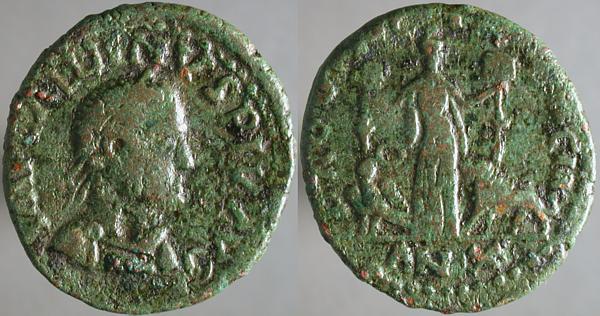
IMP GALLIENVS PIV AVG, Laureate draped cuirassed bust right | PROVINCIA DACIA, Dacia standing left, holding standards, with eagle holding wreath and lion at their bases. AN X in exergue.
Dacia, when originally established as a Roman province early in the 2nd Century CE by Trajan, was located North of the Danube. Some time during the mid-3rd Century, that was largely abandoned by the Romans, and a new Dacia established South of the Danube, in part of what had been Moesia Inferior. Today this is widely thought to have been during the reign of Aurelian (270-275), but it was previously blamed on Gallienus.

